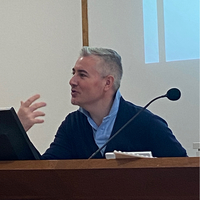
Itiel Dror
Address: www.cci-hq.com
less
Related Authors
Steven Pinker
Harvard University
Nicola Jane Holt
University of the West of England
Don Ross
University College Cork
Marc Champagne
Kwantlen Polytechnic University
David Seamon
Kansas State University
John Johnson
Pennsylvania State University
Louis de Saussure
University of Neuchâtel
Stephen Yablo
Massachusetts Institute of Technology (MIT)
Guillaume Beaulac
Concordia University (Canada)
Samuel LÉZÉ
École Normale Supérieure de Lyon










Uploads
Papers by Itiel Dror
Forensic pathologists’ decisions are critical in police investigations and court proceedings as they determine whether an unnatural death of a young child was an accident or homicide. Does cognitive bias affect forensic pathologists’ decision making? To address this question, we examined all death certificates issued during a 10-year period in the State of Nevada in the United States for children under the age of six. We also conducted an experiment with 133 forensic pathologists in which we tested whether knowledge of irrelevant non-medical information that should have no bearing on forensic pathologists’ decisions influenced their manner of death determinations. The dataset of death certificates indicated that forensic pathologists were more likely to rule "homicide" rather than "accident" for deaths of Black children relative to White children. This may arise because the base-rate expectation creates an a priori cognitive bias to rule that Black children died as a result of homicide, which then perpetuates itself. Corroborating this explanation, the experimental data with the 133 forensic pathologists exhibited biased decisions when given identical medical information but different irrelevant non-medical information about the race of the child and who was the caregiver who brought them to the hospital. These findings together demonstrate how extraneous information can result in cognitive bias in forensic pathology decision making.
https://pubs.acs.org/doi/10.1021/acs.analchem.0c00704
Fallacies about the nature of biases have shadowed a proper cognitive understanding of biases and their sources, which in turn lead to ways that minimize their impact. Six such fallacies are presented: it is an ethical issue, only applies to “bad apples”, experts are impartial and immune, technology eliminates bias, blind spot, and the illusion of control. Then, eight sources of bias are discussed and conceptualized within three categories: (A) factors that relate to the specific case and analysis, which include the data, reference materials, and contextual information, (B) factors that relate to the specific person doing the analysis, which include past experience base rates, organizational factors, education and training, and personal factors, and lastly, (C) cognitive architecture and human nature that impacts all of us. These factors can impact what the data are (e.g., how data are sampled and collected, or what is considered as noise and therefore disregarded), the actual results (e.g., decisions on testing strategies, how analysis is conducted, and when to stop testing), and the conclusions (e.g., interpretation of the results). The paper concludes with specific measures that can minimize these biases.
the degree of consistency and objectivity that underlie expert performance and decision making. To achieve consistency, experts must be reliable, at least in the very basic sense that an expert makes the same decision when the same data are presented in the same circumstances, and thus be consistent with themselves. To achieve objectivity, experts must focus only on the data and ignore irrelevant information, and thus be unbiasable by extraneous context. The analyses show that experts are not totally reliable nor are they unbiasable. These findings are based on fingerprint experts decision making, but because this domain is so well established, they apply equally well (if not more) to all other less established forensic domains.
Forensic pathologists’ decisions are critical in police investigations and court proceedings as they determine whether an unnatural death of a young child was an accident or homicide. Does cognitive bias affect forensic pathologists’ decision making? To address this question, we examined all death certificates issued during a 10-year period in the State of Nevada in the United States for children under the age of six. We also conducted an experiment with 133 forensic pathologists in which we tested whether knowledge of irrelevant non-medical information that should have no bearing on forensic pathologists’ decisions influenced their manner of death determinations. The dataset of death certificates indicated that forensic pathologists were more likely to rule "homicide" rather than "accident" for deaths of Black children relative to White children. This may arise because the base-rate expectation creates an a priori cognitive bias to rule that Black children died as a result of homicide, which then perpetuates itself. Corroborating this explanation, the experimental data with the 133 forensic pathologists exhibited biased decisions when given identical medical information but different irrelevant non-medical information about the race of the child and who was the caregiver who brought them to the hospital. These findings together demonstrate how extraneous information can result in cognitive bias in forensic pathology decision making.
https://pubs.acs.org/doi/10.1021/acs.analchem.0c00704
Fallacies about the nature of biases have shadowed a proper cognitive understanding of biases and their sources, which in turn lead to ways that minimize their impact. Six such fallacies are presented: it is an ethical issue, only applies to “bad apples”, experts are impartial and immune, technology eliminates bias, blind spot, and the illusion of control. Then, eight sources of bias are discussed and conceptualized within three categories: (A) factors that relate to the specific case and analysis, which include the data, reference materials, and contextual information, (B) factors that relate to the specific person doing the analysis, which include past experience base rates, organizational factors, education and training, and personal factors, and lastly, (C) cognitive architecture and human nature that impacts all of us. These factors can impact what the data are (e.g., how data are sampled and collected, or what is considered as noise and therefore disregarded), the actual results (e.g., decisions on testing strategies, how analysis is conducted, and when to stop testing), and the conclusions (e.g., interpretation of the results). The paper concludes with specific measures that can minimize these biases.
the degree of consistency and objectivity that underlie expert performance and decision making. To achieve consistency, experts must be reliable, at least in the very basic sense that an expert makes the same decision when the same data are presented in the same circumstances, and thus be consistent with themselves. To achieve objectivity, experts must focus only on the data and ignore irrelevant information, and thus be unbiasable by extraneous context. The analyses show that experts are not totally reliable nor are they unbiasable. These findings are based on fingerprint experts decision making, but because this domain is so well established, they apply equally well (if not more) to all other less established forensic domains.